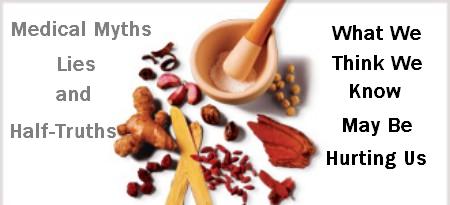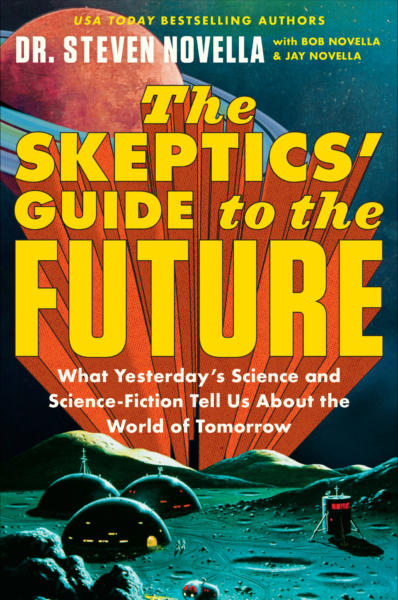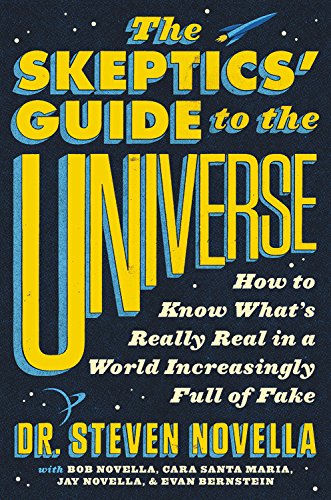Apr
22
2024
I recently received the following question to the SGU e-mail:
“I have had several conversations with friends/colleagues lately regarding indigenous beliefs/stories. They assert that not believing these based on oral histories alone is morally wrong and ignoring a different cultures method of knowledge sharing. I do not want to be insensitive, and I would never argue this point directly with an indigenous person (my friends asserting these points are all white). But it really rubs me the wrong way to be told to believe things without what I would consider more concrete evidence. I’m really not sure how to comport myself in these situations. I would love to hear any thoughts you have on this topic, as I don’t have many skeptical friends.”
I also frequently encounter this tension, between a philosophical dedication to scientific methods and respect of indigenous cultures. Similar tensions come up in other contexts, such as indigenous cultures that hunt endangered species. These tensions are sometimes framed as “decolonization” defined as “the process of freeing an institution, sphere of activity, etc. from the cultural or social effects of colonization.” Here is a more detailed description:
“Decolonization is about “cultural, psychological, and economic freedom” for Indigenous people with the goal of achieving Indigenous sovereignty — the right and ability of Indigenous people to practice self-determination over their land, cultures, and political and economic systems.”
I completely understand this concept and think the project is legitimate. To “decolonize” an indigenous culture you have to do more than just physically remove foreign settlers. Psychological and cultural colonization is harder to remove. And often cultural colonization was very deliberate, such as missionaries spreading the “correct” religion to “primitive” people.
Continue Reading »
Mar
29
2024
 I don’t think I know anyone personally who doesn’t have strong opinions about music – which genres they like, and how the quality of music may have changed over time. My own sense is that music as a cultural phenomenon is incredibly complex, no one (in my social group) really understands it, and our opinions are overwhelmed by subjectivity. But I am fascinated by it, and often intrigued by scientific studies that try to quantify our collective cultural experience. And I know there are true experts in this topic, musicologists and even ethnomusicologists, but haven’t found good resources for science communication in this area (please leave any recommendations in the comments).
I don’t think I know anyone personally who doesn’t have strong opinions about music – which genres they like, and how the quality of music may have changed over time. My own sense is that music as a cultural phenomenon is incredibly complex, no one (in my social group) really understands it, and our opinions are overwhelmed by subjectivity. But I am fascinated by it, and often intrigued by scientific studies that try to quantify our collective cultural experience. And I know there are true experts in this topic, musicologists and even ethnomusicologists, but haven’t found good resources for science communication in this area (please leave any recommendations in the comments).
In any case, here are some random bits of music culture science that I find interesting. A recent study analyzing 12,000 English language songs over the last 40 years has found that songs have been getting simpler and more repetitive over time. They are using fewer words with greater repetition. Further, the structure of the lyrics are getting simpler, and they are more readable and easier to understand. Also, the use of emotional words has increased, and has become overall more negative and more personal. I have to note this is a single study and there are some concerns about the software used in the analysis, but while this is being investigated the authors state that it is unlikely any glitch will alter their basic findings.
But taken at face value, it’s interesting that these findings generally fit with my subjective experience. This doesn’t necessarily make me more confident in the findings, and I do worry that I am just viewing these results through my confirmation bias filter. Still, it not only fits what I have perceived in music but in culture in general, especially with social media. We should be wary of simplistic explanations, but I wonder if this is mainly due to a general competition for attention. Overtime there is a selective pressure for media that is more immediate, more emotional, and easier to consume. The authors also speculate that it may reflect our changing habits in terms of consuming media. There is a greater tendency to listen to music, for example, in the background, while doing other things (perhaps several other things).
Continue Reading »
Feb
15
2024
A recent study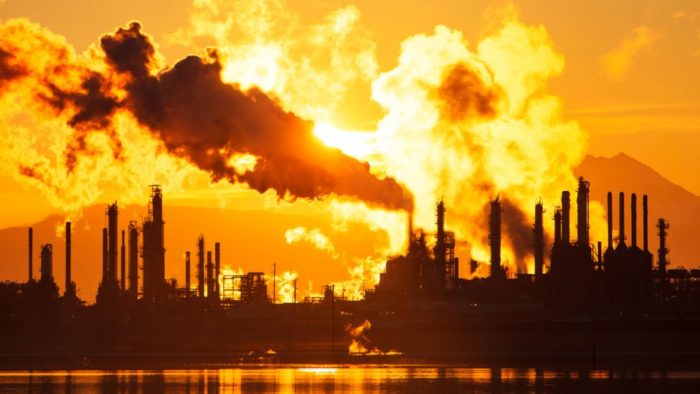 finds that 14.8% of Americans do not believe in global climate change. This number is roughly in line with what recent survey have found, such as this 2024 Yale study which put the figure at 16%. In 2009, by comparison, the figure was at 33% (although this was a peak – the 2008 result was 21%). The numbers are also encouraging when we ask about possible solutions, with 67% of Americans saying that we should prioritize development of green energy and should take steps to become carbon neutral by 2050. The good news is that we now have a solid majority of Americans who accept the consensus on climate change and broadly support measures to reduce our carbon footprint.
finds that 14.8% of Americans do not believe in global climate change. This number is roughly in line with what recent survey have found, such as this 2024 Yale study which put the figure at 16%. In 2009, by comparison, the figure was at 33% (although this was a peak – the 2008 result was 21%). The numbers are also encouraging when we ask about possible solutions, with 67% of Americans saying that we should prioritize development of green energy and should take steps to become carbon neutral by 2050. The good news is that we now have a solid majority of Americans who accept the consensus on climate change and broadly support measures to reduce our carbon footprint.
But there is another layer to this study I first mentioned – the methods used in deriving the numbers. It was not a survey. It used artificial intelligence to analyze posts on X (Twitter) and their networks. The fact that the results aligns fairly well to more tried and true methods, like surveys, is somewhat validating of the methods. Of course surveys can be variable as well, depending on exactly how questions are asked and how populations are targeted. But multiple well designed survey by experienced institutions, like Pew, can create an accurate picture of public attitudes.
The advantage of analyzing social media is that it can more easily provide vast amounts of data. The authors report:
We used a Deep Learning text recognition model to classify 7.4 million geocoded tweets containing keywords related to climate change. Posted by 1.3 million unique users in the U.S., these tweets were collected between September 2017 and May 2019.
Continue Reading »
Nov
28
2023
 In my second book (shameless plug alert) – The Skeptics’ Guide to the Future – my coauthors and I try to imagine both the utopian and dystopian versions of the future, brought about by technology, either individually or collectively. This topic has come up multiple times recently on this blog when discussing technology and trust in science and scientists, so I thought it deserved its own discussion.
In my second book (shameless plug alert) – The Skeptics’ Guide to the Future – my coauthors and I try to imagine both the utopian and dystopian versions of the future, brought about by technology, either individually or collectively. This topic has come up multiple times recently on this blog when discussing technology and trust in science and scientists, so I thought it deserved its own discussion.
The overarching point is that science and technology should not be thought of as pure objective good, but rather they are tools, and tools can be used for good or evil. I admit I am a science enthusiast and a technophile, also a bit of an optimist, so when I hear about a new discovery or technology my first thoughts go to all the ways that it might make life better, or at least cooler. I have to remember to consider all the ways in which the technology can also be abused or exploited, which is why we explicitly did this in our futurism book.
So far, on the balance I think science and technology has been an incredible plus to humanity. For most of human existence life was “short, nasty, and brutish.” Science has given us a greater perspective on ourselves and the universe, freeing us from ignorance and superstition. And technology has given us the power to extend our lives, improve our health, and control our environment. It enables us to peer deep into the universe, and see for the first time a microscopic world that was always there but we had no idea existed. It enables us to travel beyond the confines of our planet, and eventually (if we survive) will enable us to be a multi-world, and even multi-system, species.
I do think we have lost touch with how bad life was prior to modern technology. Our period movies, for example, are highly romanticized. A brutally accurate portrayal of life prior to the industrial revolution would show people with horrible dentition ravaged by diseases and living mostly in drudgery. Most people never saw the world beyond their small village. We get a hint of this sometimes, but never the reality.
Continue Reading »
Nov
16
2023
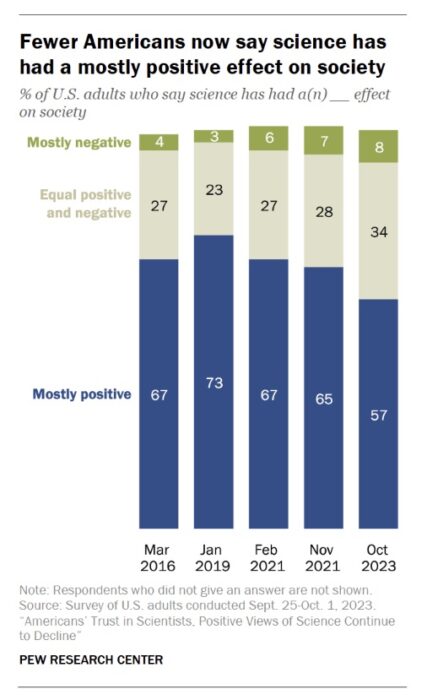 How much does the public trust in science and scientists? Well, there’s some good news and some bad news. Let’s start with the bad news – a recent Pew survey finds that trust in scientist has been in decline for the last few years. From its recent peak in 2019, those who answered that science has a mostly positive effect on society decreased from 73% to 57%. Those who say it has a mostly negative effect increased from 3 to 8%. Those who trust in scientists a fair amount or a great deal decreased from 86 to 73%. Those who think that scientific investments are worthwhile remain strong at 78%.
How much does the public trust in science and scientists? Well, there’s some good news and some bad news. Let’s start with the bad news – a recent Pew survey finds that trust in scientist has been in decline for the last few years. From its recent peak in 2019, those who answered that science has a mostly positive effect on society decreased from 73% to 57%. Those who say it has a mostly negative effect increased from 3 to 8%. Those who trust in scientists a fair amount or a great deal decreased from 86 to 73%. Those who think that scientific investments are worthwhile remain strong at 78%.
The good news is that these numbers are relatively high compared to other institutions and professions. Science and scientists still remain among the most respected professions, behind the military, teachers, and medical doctors, and way above journalists, clergy, business executives, and lawyers. So overall a majority of Americans feel that science and scientists are trustworthy, valuable, and a worthwhile investment.
But we need to pay attention to early warning signs that this respect may be in jeopardy. If we get to the point that a majority of the public do not feel that investment in research is worthwhile, or that the findings of science can be trusted, that is a recipe for disaster. In the modern world, such a society is likely not sustainable, certainly not as a stable democracy and economic leader. It’s worthwhile, therefore, to dig deeper on what might be behind the recent dip in numbers.
It’s worth pointing out some caveats. Surveys are always tricky, and the results depend heavily on how questions are asked. For example, if you ask people if they trust “doctors” in the abstract the number is typically lower than if you ask them if they trust their doctor. People tend to separate their personal experience from what they think is going on generally in society, and are perhaps too willing to dismiss their own evidence as “exceptions”. If they were favoring data over personal anecdote, that would be fine. But they are often favoring rumor, fearmongering, and sensationalism. Surveys like this, therefore, often reflect the public mood, rather than deeply held beliefs.
Continue Reading »
Nov
14
2023
 What is “natural” for humans? It’s often hard to say, and in my opinion this is a highly overused concept. Primarily this is because humans are adaptable – we adapt to our environment, our situation, and our culture. So it is “natural” for us not to have a natural state.
What is “natural” for humans? It’s often hard to say, and in my opinion this is a highly overused concept. Primarily this is because humans are adaptable – we adapt to our environment, our situation, and our culture. So it is “natural” for us not to have a natural state.
But this does not mean there are no insights to be gained by considering the evolutionary milieu in which our ancestors spent the vast majority of their existence. By rapidly changing our environment we may be pushing the limits of our adaptability. We also need to consider the difference between surviving and thriving. We may survive in the world we have created for ourselves, but pay some price. For those of us living in industrialized societies, it’s also difficult to appreciate how different our lives are from the vast majority of human history and societies. What is now “normal” for us is a recent anomaly.
We can apply this line of thinking to many aspects of our lives, but I want to consider childcare. A recent study looking at Mbendjele BaYaka Hunter-Gatherers in the Republic of Congo found a number of interesting thing regarding childcare. Young children received physical contact for the majority of their day. Overall they had near constant attention from a caretaker. About half of this attention came from someone other than the child’s mother or parents. Children benefitted form a network of caregivers of 10 or more people, and occasionally as many as 20 or more. Older children, teenagers, and adult relatives all contributed to childcare. These networks potentially have a number of implications.
Continue Reading »
Oct
30
2023
 How is American democracy doing, and what can we do to improve it, if necessary? This is clearly a question of political science, and I am not a political scientist, and this is not a political blog. But there are some basic principles of critical thinking that might apply, and the second word in “political science” is “science”. Further, while this is not a political blog, what that really means is that I endeavor to be non-partisan. I am not trying to advocate for any particular party or ideological group. But many of the issues I discuss have a political dimension, because most issues do. Global warming is a scientific question, but there are massive political consequences, for example.
How is American democracy doing, and what can we do to improve it, if necessary? This is clearly a question of political science, and I am not a political scientist, and this is not a political blog. But there are some basic principles of critical thinking that might apply, and the second word in “political science” is “science”. Further, while this is not a political blog, what that really means is that I endeavor to be non-partisan. I am not trying to advocate for any particular party or ideological group. But many of the issues I discuss have a political dimension, because most issues do. Global warming is a scientific question, but there are massive political consequences, for example.
So if you will indulge me, I want to apply some basic critical thinking principles to some pressing questions regarding our democracy. My goal is to see if we can find some common ground. This is something I frequently recommend in many contexts – if you are trying to convince someone that a particular belief of theirs is pseudoscience, a good place to start is to establish some common ground and then proceed from there. Otherwise you will likely be talking past each other.
Also, despite the fact that we seem to be having increasing partisan division in this country, my sense is that we still have much more common ground than may be apparent. The media and politicians both benefit from emphasizing division, conflict, and differences. Keeping everyone as outraged and agitated as possible maximizes clicks and votes. Both polling and personal experience, if you look beyond the surface level, also tell a story of common ground. Most common-sense positions are supported by large majorities. Most people want basically the same things – safety, prosperity, liberty, transparency and fairness. This is not to minimize the very real different value judgements that exist in society. This is why we need democracy to work out compromises.
Continue Reading »
Oct
05
2023
One side benefit of our federalist system is that the US essentially has 50 experiments in democracy. States hold a lot of power, which provides an opportunity to compare the effects of different public policies. There are lots of other variables at play, such as economics, rural vs urban residents, and climate, but with so many different states, and counties within those states, researchers often have enough data to account for these variables.
While the differences among the states go beyond red state vs blue state, this is an important factor when it comes to public policy, and there is at least one fairly consistent ideological difference. Red states tend to favor policies the lean toward liberty and are pro-business. Blue states are more willing to enact public policy that limits freedom or regulates business but are designed to benefit public health. These public health policies are often denigrated by conservatives as the “nanny state” – portraying the government as a caretaker and citizens as children.
Across the 50 states there is more of a continuum than a sharp divide, both politically and in public policy, again providing a natural experiment of the effects and costs of such policies. It’s not my point to say which approach is “right” because there is a tradeoff and a value judgement involved. One bit of conventional wisdom I agree with is that in politics there are no solutions, only tradeoffs. How much freedom are we willing to give up for security, and how much inconvenience are we willing to put up with for improved health?
Continue Reading »
Aug
22
2023
 What does a majestic eagle sound like, or the hoot of a spider monkey, or the roar of a bear? Unless you have an interest in movie tropes, or listen regularly to the SGU, you may have a complete misconception about the sounds these and many other animals make. Eagles, for example, do not make that cool-sounding screech that is almost always paired with a video of an eagle. That is the sound of a red-tailed hawk, which has become the standard sound movies use for any raptor. Eagles make a high-pitched chirping sound. If you have seen a bear roar in a movie, chances are the sound you heard was that of a tiger. All primates hoot like a chimp, all frogs “ribbit” like that one species whose range includes Hollywood.
What does a majestic eagle sound like, or the hoot of a spider monkey, or the roar of a bear? Unless you have an interest in movie tropes, or listen regularly to the SGU, you may have a complete misconception about the sounds these and many other animals make. Eagles, for example, do not make that cool-sounding screech that is almost always paired with a video of an eagle. That is the sound of a red-tailed hawk, which has become the standard sound movies use for any raptor. Eagles make a high-pitched chirping sound. If you have seen a bear roar in a movie, chances are the sound you heard was that of a tiger. All primates hoot like a chimp, all frogs “ribbit” like that one species whose range includes Hollywood.
The same is true of soundscapes. If there is a scene of a jungle, then you will hear a classic jungle soundscape, even if it includes animals from a different continent. If you are in a more foreboding or swampy area, you will hear a loon. Doesn’t matter where the actual location is supposed to be.
I understand why this is the case. Modern moviemaking is, in part, an agreed-upon cultural language. The writer/director/costumer/set-dresser/editor/music director are all communicating to the audience. They are trying to efficiently create a mood, or convey a situation, or signal to the audience something about a location or a character. There are ways to do this using a pre-existing movie language. If someone just came back from grocery shopping, the paper bags they are carrying will have a baguette sticking out the top, and/or carrot tops. This is not because, statistically, that is what a grocery bag is likely to contain, but rather it instantly lets the audience know what they are.
Similarly, with animals sounds, a majestic animal must sound majestic. A large predator must roar like a large predator. The problem for movie makers is that often reality does not sound real enough. It doesn’t convey the emotion or danger that a scene might require.
Continue Reading »
Jun
20
2023
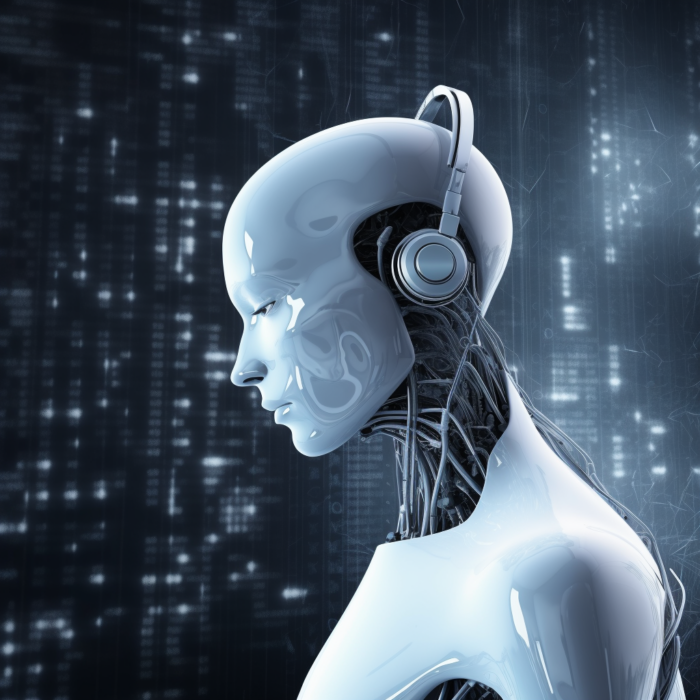 I’ve been following AI (artificial intelligence) news very closely, including all the controversies and concerns. I tend to fall on the side of – AI is a powerful tool, we should continue to develop it and use it responsibly. We don’t need to panic, and highly restrictive laws are likely unnecessary and counterproductive. But there are legitimate concerns about the power of AI, especially in the “wrong” hands. I also think the greatest disruption to our lives might not come from cyberterrorists (although a legit concern) or AI run amok, but from marketing. Giving companies who see us only as customers the power to predict our every move gives me pause.
I’ve been following AI (artificial intelligence) news very closely, including all the controversies and concerns. I tend to fall on the side of – AI is a powerful tool, we should continue to develop it and use it responsibly. We don’t need to panic, and highly restrictive laws are likely unnecessary and counterproductive. But there are legitimate concerns about the power of AI, especially in the “wrong” hands. I also think the greatest disruption to our lives might not come from cyberterrorists (although a legit concern) or AI run amok, but from marketing. Giving companies who see us only as customers the power to predict our every move gives me pause.
This AI news item falls into this latter category – the use of machine learning AI to predict which songs people will like. Seems innocuous, but I think it furthers a trend that has some serious downsides. This is what the researchers did:
Traditionally, song elements have been measured from large databases to identify the lyrical aspects of hits. We took a different methodological approach, measuring neurophysiologic responses to a set of songs provided by a streaming music service that identified hits and flops. We compared several statistical approaches to examine the predictive accuracy of each technique. A linear statistical model using two neural measures identified hits with 69% accuracy. Then, we created a synthetic set data and applied ensemble machine learning to capture inherent non-linearities in neural data. This model classified hit songs with 97% accuracy.
This kind of approach is called neuroforecasting – predicting people’s likes and dislikes based upon their brain activity and physiological responses (like a lie detector but for your reaction to music). First let me point out that this study used a synthetic set of data, and is therefore just a proof of concept – this approach can theoretically work. They need to test this in the real world, and see if it can predict hits, not just match the model to existing hits. But let’s assume it works, and the 97% accuracy hold up. What will this mean for the music and streaming industries?
Continue Reading »

 I don’t think I know anyone personally who doesn’t have strong opinions about music – which genres they like, and how the quality of music may have changed over time. My own sense is that music as a cultural phenomenon is incredibly complex, no one (in my social group) really understands it, and our opinions are overwhelmed by subjectivity. But I am fascinated by it, and often intrigued by scientific studies that try to quantify our collective cultural experience. And I know there are true experts in this topic, musicologists and even ethnomusicologists, but haven’t found good resources for science communication in this area (please leave any recommendations in the comments).
I don’t think I know anyone personally who doesn’t have strong opinions about music – which genres they like, and how the quality of music may have changed over time. My own sense is that music as a cultural phenomenon is incredibly complex, no one (in my social group) really understands it, and our opinions are overwhelmed by subjectivity. But I am fascinated by it, and often intrigued by scientific studies that try to quantify our collective cultural experience. And I know there are true experts in this topic, musicologists and even ethnomusicologists, but haven’t found good resources for science communication in this area (please leave any recommendations in the comments).
 In my second book (shameless plug alert) –
In my second book (shameless plug alert) –  How much does the public trust in science and scientists? Well, there’s some good news and some bad news. Let’s start with the bad news –
How much does the public trust in science and scientists? Well, there’s some good news and some bad news. Let’s start with the bad news – What is “natural” for humans? It’s often hard to say, and in my opinion this is a highly overused concept. Primarily this is because humans are adaptable – we adapt to our environment, our situation, and our culture. So it is “natural” for us not to have a natural state.
What is “natural” for humans? It’s often hard to say, and in my opinion this is a highly overused concept. Primarily this is because humans are adaptable – we adapt to our environment, our situation, and our culture. So it is “natural” for us not to have a natural state. How is American democracy doing, and what can we do to improve it, if necessary? This is clearly a question of political science, and I am not a political scientist, and this is not a political blog. But there are some basic principles of critical thinking that might apply, and the second word in “political science” is “science”. Further, while this is not a political blog, what that really means is that I endeavor to be non-partisan. I am not trying to advocate for any particular party or ideological group. But many of the issues I discuss have a political dimension, because most issues do. Global warming is a scientific question, but there are massive political consequences, for example.
How is American democracy doing, and what can we do to improve it, if necessary? This is clearly a question of political science, and I am not a political scientist, and this is not a political blog. But there are some basic principles of critical thinking that might apply, and the second word in “political science” is “science”. Further, while this is not a political blog, what that really means is that I endeavor to be non-partisan. I am not trying to advocate for any particular party or ideological group. But many of the issues I discuss have a political dimension, because most issues do. Global warming is a scientific question, but there are massive political consequences, for example. What does a majestic eagle sound like, or the hoot of a spider monkey, or the roar of a bear?
What does a majestic eagle sound like, or the hoot of a spider monkey, or the roar of a bear?  I’ve been following AI (artificial intelligence) news very closely, including all the controversies and concerns. I tend to fall on the side of – AI is a powerful tool, we should continue to develop it and use it responsibly. We don’t need to panic, and highly restrictive laws are likely unnecessary and counterproductive. But there are legitimate concerns about the power of AI, especially in the “wrong” hands. I also think the greatest disruption to our lives might not come from cyberterrorists (although a legit concern) or AI run amok, but from marketing. Giving companies who see us only as customers the power to predict our every move gives me pause.
I’ve been following AI (artificial intelligence) news very closely, including all the controversies and concerns. I tend to fall on the side of – AI is a powerful tool, we should continue to develop it and use it responsibly. We don’t need to panic, and highly restrictive laws are likely unnecessary and counterproductive. But there are legitimate concerns about the power of AI, especially in the “wrong” hands. I also think the greatest disruption to our lives might not come from cyberterrorists (although a legit concern) or AI run amok, but from marketing. Giving companies who see us only as customers the power to predict our every move gives me pause.